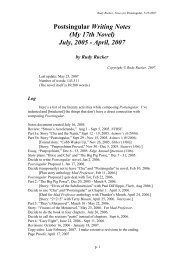Notes for the Lifebox, the Seashell, and the Soul - Rudy Rucker
Notes for the Lifebox, the Seashell, and the Soul - Rudy Rucker
Notes for the Lifebox, the Seashell, and the Soul - Rudy Rucker
Create successful ePaper yourself
Turn your PDF publications into a flip-book with our unique Google optimized e-Paper software.
<strong>Notes</strong> <strong>for</strong> The <strong>Lifebox</strong>, <strong>the</strong> <strong>Seashell</strong>, <strong>and</strong> <strong>the</strong> <strong>Soul</strong>, by <strong>Rudy</strong> <strong>Rucker</strong><br />
Category<br />
Job<br />
Company<br />
Author<br />
Movie<br />
Artist<br />
Web page<br />
City<br />
Person<br />
Success<br />
Salary<br />
Net Income<br />
Average book advance<br />
Gross receipts on opening weekend<br />
Average price paid <strong>for</strong> a work<br />
Number of links to this page<br />
Population<br />
Number of close acquaintances<br />
In each case we can draw a graph of how <strong>the</strong> success value drops off as we move<br />
from <strong>the</strong> higher ranking towards <strong>the</strong> lower ranking individuals in a class. As it turns out,<br />
<strong>the</strong>se graphs tend to drop off more steeply than one might expect. They obey distribution<br />
rules known as power laws. Zipf’s law is an especially simple power law. In <strong>the</strong> more<br />
general case, <strong>the</strong> rank may be raised to some power D. So we expect <strong>for</strong> each individual in<br />
<strong>the</strong> sample,<br />
Success measure of an individual I = C / (Success rank of <strong>the</strong> individual I) D<br />
Now in many situations, it turns out not to be practical to rank <strong>the</strong> entire sample in<br />
order of success. It can be more useful to express a power law in terms of <strong>the</strong> probability of<br />
finding an individual of a certain level. In terms of salaries, <strong>for</strong> instance, we might take a<br />
large sample of people, determine <strong>the</strong>ir salaries, <strong>and</strong> determine <strong>the</strong> probability of finding a<br />
person at each salary level. In this case <strong>the</strong> power law could be written in this <strong>for</strong>m.<br />
Success measure S = A / (Probability of finding an object with success measure<br />
S) D The two kinds of power laws are roughly equivalent.<br />
In order to graph <strong>the</strong>se kinds of laws, scientists often use what’s called logarithmic<br />
graph paper. That is, <strong>the</strong> scales along <strong>the</strong> two axes can be set to, say, powers of ten instead of<br />
measuring uni<strong>for</strong>mly along <strong>the</strong> axis. If we do this we are in effect plotting log(y) against<br />
log(x), which has <strong>the</strong> effect of turning power-law graphs into downward-sloping straight<br />
lines which are more or less steep depending on <strong>the</strong> size of D. 7<br />
7 Suppose I take my logarithms to base ten, <strong>and</strong> u <strong>and</strong> v are, respectively <strong>the</strong> log base ten of y<br />
<strong>and</strong> x. This means that x = 10 u <strong>and</strong> y = 10 v . In this case, a power law of <strong>the</strong> <strong>for</strong>m y = C/x D has <strong>the</strong><br />
<strong>for</strong>m y = x -D because a negative exponent means division.<br />
We can convert this step by step to a linear equation giving v as a function of u.<br />
10 v = (C * 10 u ) -D<br />
log(10 v ) = log((C * 10 u ) -D ) because <strong>the</strong> logs of equals are still equal.<br />
log(10 v ) = log(C) + -D * log((10 u )) because logarithms turn products into sums <strong>and</strong> exponents into<br />
products.<br />
v = log(C) - D*u because <strong>the</strong> log base ten of 10 a is always just a.<br />
v = B - D*u, writing B <strong>for</strong> <strong>the</strong> constant log(C).<br />
p. 89
















